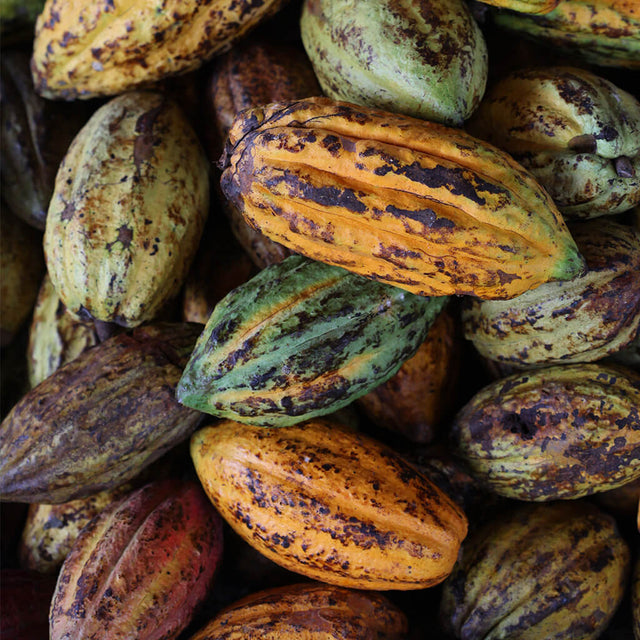SINGLE ORIGIN, TERROIR, ETHICAL SOURCING... What does it all mean and how do these things all fit together?
Written by Gretta Siegel
WHAT DOES IT MEAN WHEN CHOCOLATE IS LABELED ‘SINGLE-ORIGIN’?
It means that that the cacao beans are all grown in a single country and in our case, at a single cacao farm/plantation. By working with a single plantation, there is opportunity to develop a healthy relationship between the grower and the chocolate company purchasing the product. There is less anonymity and more collaboration. And within that single origin location, there is opportunity to explore the range of terroir of the particular farm.
PHOTOGRAPHY: LAURENT VU FOR VALRHONA
SO WHAT IS TERROIR?
Terroir, a term popularized by the wine industry, was used back in the 17th century to describe horrible wines, owing their horribleness to the land where the grapes were produced. Yet by the 20th century, after a variety of factors led the French wine industry to create strict rules regarding labeling relative to location – terroir became a term and concept to further distinguish products in a positive fashion. Expanding from the wine industry, chocolate companies have developed a strong interest in terroir. Terroir is determined by physical as well as cultural factors. The chemical composition of the soil, the slope and direction of the hillsides, the micro-organisms in the soil, the humidity of the environment, the flora and fauna of the area – these are some of the physical characteristics that contribute to giving a particular plot of land its terroir. The cultural side of terroir takes into consideration the longevity of the history of cultivation in the region. Is the product considered culturally intrinsic to the place where it is produced?
PHOTOGRAPHY: LAURENT VU FOR VALRHONA
So terroir is fun and interesting to delve into as a very important aspect of single origin chocolate, though it is not the only one. If the beans are harvested from multiple points of origin and kept separate, and then undergo identical post-processing – then the distinctions can be much more identifiable and more attributable to terroir. This would be true when comparing a final product from different plots on a single plantation, as well as comparing final products from different countries.
However, terroir is not the only aspect of chocolate production that influences the unique flavors of the single origins. There are genetic factors – what hybrids have been developed and carried forward over the decades or centuries in the region? There are factors of agronomy - what are the agricultural practices in place for the crops? And there are post-harvest practices that influence flavor – for example the drying and fermentation processes.
PHOTOGRAPHY: P. OLLIER FOR VALRHONA
For so many years, the goal of chocolate producers has been to produce a uniform product that tastes ‘like chocolate’ and to condition consumers to expect that consistent flavor (basically the taste of sugar and vanilla). They worked hard to erase any bitterness or unique flavor profiles. In the 1990s though, the French company Valrhona took the lead in exploring single-origins and the wide variety of chocolate experiences that could result from bringing unique characteristics from single origins to the fore. To move from standardization to appreciation of place and culture. To broaden the consumer palate. And to be freed from the burden of uniformity in order to create products of exceptional quality. Thus – chocolate can taste nutty, or fruity, or grassy, or any number of other adjectives that are conjured by our senses of smell, taste, and memory. Given focus, tastings of single-origin chocolates can be an exciting and adventurous experience!

PHOTOGRAPHY: LAURENT VU FOR VALRHONA
ANOTHER APPEALING ASPECT OF SINGLE ORIGIN CHOCOLATE IS TRACEABILITY
Consumers are increasingly interested in where their food comes from and how it is farmed or produced. To quote the motto of the Slow Food movement, people want their food to be ‘good, clean, and fair’. When the cacao comes from a single origin – more can be known about it. What are the child labor laws governing the country? What are the employment practices of the specific plantation? Are the farmers getting a fair price for their product? What level of pesticides are being used? Are there heavy metals or other pollutants prevalent in the soil where the cacao is being grown? These are questions that more and more people are asking, and they are easier to answer when the cacao is sourced from a single origin, and when there are good, strong, collaborative relationships in place between the growers, the processors, the chocolatiers, and the people developing, packaging, marketing, and selling the final product.
PHOTOGRAPHY: CHOCOLAT-E
At Chocolat-e, we are so very proud of our partnership with Valrhona, with their ethical sourcing practices, and with our final products through which we can share with you the delicious benefits of terroir-driven single-origin chocolate.






